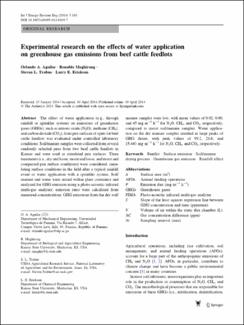| dc.contributor.author | A. Aguilar, Orlando | |
| dc.contributor.author | Maghirang, Ronaldo | |
| dc.contributor.author | L. Trabue, Steven | |
| dc.contributor.author | E. Erickson, Larry | |
| dc.date.accessioned | 2018-03-16T20:40:38Z | |
| dc.date.accessioned | 2018-03-16T20:40:38Z | |
| dc.date.available | 2018-03-16T20:40:38Z | |
| dc.date.available | 2018-03-16T20:40:38Z | |
| dc.date.issued | 2014-04-30 | |
| dc.date.issued | 2014-04-30 | |
| dc.identifier | https://link.springer.com/article/10.1007/s40095-014-0103-7 | |
| dc.identifier.issn | 2008-9163 | |
| dc.identifier.uri | http://ridda2.utp.ac.pa/handle/123456789/4425 | |
| dc.identifier.uri | http://ridda2.utp.ac.pa/handle/123456789/4425 | |
| dc.description | The effect of water application (e.g., through rainfall or sprinkler system) on emissions of greenhouse gases (GHGs), such as nitrous oxide (N2O), methane (CH4), and carbon dioxide (CO2), from pen surfaces of open-lot beef cattle feedlots was evaluated under controlled laboratory conditions. Soil/manure samples were collected from several randomly selected pens from two beef cattle feedlots in Kansas and were used as simulated pen surfaces. Three treatments (i.e., dry and loose, moist and loose, and moist and compacted pen surface conditions) were considered, simulating surface conditions in the field after a typical rainfall event or water application with a sprinkler system. Soil/manure and water were mixed within glass containers and analyzed for GHG emission using a photo-acoustic infrared multi-gas analyzer; emission rates were calculated from measured concentrations. GHG emissions from the dry soil/manure samples were low, with mean values of 0.02, 0.00, and 45 mg m−2 h−1 for N2O, CH4, and CO2, respectively, compared to moist soil/manure samples. Water application on the dry manure samples resulted in large peaks of GHG fluxes, with peak values of 99.2, 28.6, and 15,443 mg m−2 h−1 for N2O, CH4, and CO2, respectively. | en_US |
| dc.description.abstract | The effect of water application (e.g., through rainfall or sprinkler system) on emissions of greenhouse gases (GHGs), such as nitrous oxide (N2O), methane (CH4), and carbon dioxide (CO2), from pen surfaces of open-lot beef cattle feedlots was evaluated under controlled laboratory conditions. Soil/manure samples were collected from several randomly selected pens from two beef cattle feedlots in Kansas and were used as simulated pen surfaces. Three treatments (i.e., dry and loose, moist and loose, and moist and compacted pen surface conditions) were considered, simulating surface conditions in the field after a typical rainfall event or water application with a sprinkler system. Soil/manure and water were mixed within glass containers and analyzed for GHG emission using a photo-acoustic infrared multi-gas analyzer; emission rates were calculated from measured concentrations. GHG emissions from the dry soil/manure samples were low, with mean values of 0.02, 0.00, and 45 mg m−2 h−1 for N2O, CH4, and CO2, respectively, compared to moist soil/manure samples. Water application on the dry manure samples resulted in large peaks of GHG fluxes, with peak values of 99.2, 28.6, and 15,443 mg m−2 h−1 for N2O, CH4, and CO2, respectively. | en_US |
| dc.language | eng | |
| dc.language.iso | eng | en_US |
| dc.rights | info:eu-repo/semantics/restrictedAccess | |
| dc.subject | Feedlot | en_US |
| dc.subject | Surface emission | en_US |
| dc.subject | Soil/manure drying process | en_US |
| dc.subject | Greenhouse gas emission | en_US |
| dc.subject | Rainfall effect | en_US |
| dc.subject | Feedlot | |
| dc.subject | Surface emission | |
| dc.subject | Soil/manure drying process | |
| dc.subject | Greenhouse gas emission | |
| dc.subject | Rainfall effect | |
| dc.title | Experimental research on the effects of water application on greenhouse gas emissions from beef cattle feedlots | en_US |
| dc.type | info:eu-repo/semantics/article | |
| dc.type | info:eu-repo/semantics/publishedVersion | |
